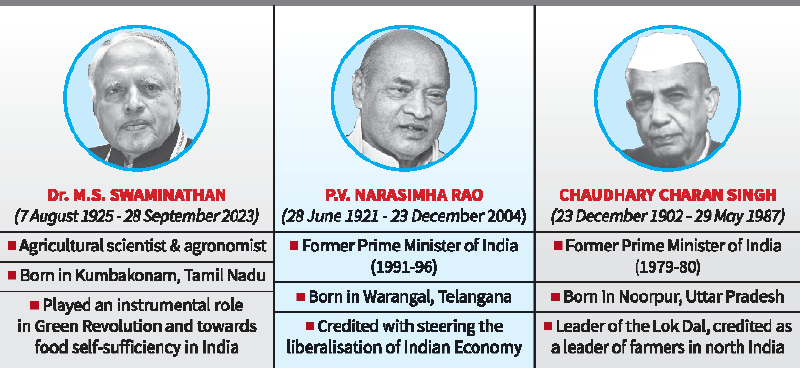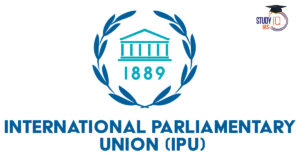Table of Contents
Bharat Ratna
Context: The Bharat Ratna will be conferred on former Prime Ministers P.V. Narasimha Rao and Chaudhary Charan Singh, M.S. Swaminathan.

| More in News |
| Tally of five awardees makes this year’s list the longest ever, surpassing four awardees in 1999 |
P.V. Narasimha Rao
- Early Life and Education:
- Born on June 28, 1921, in Hyderabad state.
- Freedom fighter, academician, and literary figure.
- Translated the famous Telugu novel “Veyi Padagalu” to Hindi as “SahasraPhan”.
- Political Career: 9th Prime Minister of India (1991-1996).
- Credited with ushering in economic liberalisation in India.
Chaudhary Charan Singh
- Early Life and Background:
- Born in 1902, Noorpur, Meerut district, Uttar Pradesh.
- Champion of rural and agricultural development.
- Political Career:
- Prime Minister of India (July 1979 – January 1980).
- Contributions to Agriculture:
- Played a key role in formulating the Debt Redemption Bill of 1939, providing relief to debt-burdened farmers.
- Instrumental in implementing the Land Holding Act of 1960, aiming for uniform land ceiling limits across the state.
- Literary Contributions:
- Notable works include “Abolition of Zamindari”, “Co-operative Farming X-rayed”, and “India’s Poverty and its Solution”.
Dr. M.S. Swaminathan
- Birth: Aug 7, 1925, Kumbakonam, Tamil Nadu
- Influenced by: Mahatma Gandhi’s principles
- Career shift: From medicine to agriculture after witnessing the Bengal famine of 1942-43
- Key roles:
- Director General of ICAR
- Independent Chairman of FAO Council
- Leadership positions in international agricultural organizations
- Legacy:
- “Father of India’s Green Revolution“
- Pioneered the introduction of high-yielding varieties of wheat and rice
- Emphasised farmer education and sustainable agricultural practices
We’re now on WhatsApp. Click to Join
Preamble – Amendability
Context: The Supreme Court is looking into the amendability of the Preamble based on the petition for deletion of words secular and socialist from the Preamble.
Amendment to the Preamble
- Can the Preamble be Amended?: Yes, but with limitations.
- Key Points:
- Landmark case: Kesavananda Bharati (1973) established the Preamble as part of the Constitution, open to amendment under Article 368.
- Restriction: Amendments cannot alter the “Basic Structure” of the Constitution.
- Basic Structure: Not explicitly defined, but generally understood to include core principles like democracy, federalism, secularism, rule of law, and fundamental rights.
- Number of amendments: Only one amendment has been made to the Preamble through the 42nd Amendment Act (1976).
- Basis: Recommendations by the Sardar Swaran Singh Committee.
- Additions: Three new words:
- Socialist
- Secular
- Integrity
India – Saudi Military Exercise
Context: Sada Tanseeq (maiden joint military exercise) between the Indian Army and the Royal Saudi Land Force was concluded in Jaipur.
About Sada Tanseeq
- Objective:
- Improve interoperability between the Indian and Saudi Arabian armies.
- Familiarise both forces with each other’s operational procedures and combat drills under UN mandate.
- Participants:
- India: 20th Battalion of The Brigade of Guards Regiment.
- Saudi Arabia: 45 soldiers of the Royal Saudi Land Force.
- Duration: 12-day exercise
HAPS
Context: The National Aerospace Laboratories (NAL) had completed the first test of High Altitude Pseudo Satellite (HAPS).
About HAPS
- Developed by: National Aerospace Laboratories (NAL), Bengaluru, India
- Purpose: Enhance India’s surveillance and monitoring capabilities, especially in border areas.
- Key Features:
- It is capable of flying at altitudes of 18-20 kilometres above the ground.
- It’s designed to be solar-powered, allowing it to remain airborne for extended periods, potentially for months, without needing to land.
- Dubbed a “pseudo-satellite” for functionalities similar to satellites, including sustained high-altitude surveillance.
- Potential Applications: Border security, telecommunications, weather monitoring, aerial imaging, and more.


 SAMARTH Udyog Bharat 4.0: Transforming I...
SAMARTH Udyog Bharat 4.0: Transforming I...
 BHIM 3.0 Launched by NPCI: Key Features,...
BHIM 3.0 Launched by NPCI: Key Features,...
 150th Summit of Inter-Parliamentary Unio...
150th Summit of Inter-Parliamentary Unio...





















